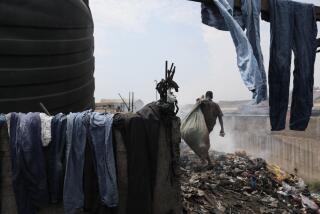Workers’ Rights at Risk
Maseru, Lesotho — After a local clothing factory owner refused to hand over dues collected by a union, labor leader Bahlakoana Shaw Lebakae turned to an unlikely ally: Gap Inc.
Shortly after being contacted by the U.S. retailer, the owner -- which has since gone out of business -- paid up.
Once routinely reviled as a perpetrator of sweatshop misery in the developing world, San Francisco-based Gap is now viewed as a leader in the small but growing corporate movement to improve conditions for some of the world’s most exploited workers.
“Gap is different,” said Lebakae, who spends many nights visiting shantytowns on the outskirts of this capital city, home to many of Lesotho’s 55,000 garment workers.
By leveraging its power as a major buyer of T-shirts, khaki pants and other apparel, Gap has brought together feuding labor leaders and factory owners in Lesotho and other African countries, helped train independent factory monitors in Central America and supported a program in Cambodia that provides expanded access to the U.S. apparel and textile market in exchange for improved factory conditions.
Gap Chief Executive Paul Pressler told a recent industry gathering that he intended to use the demise of apparel and textile import quotas to improve the image of an industry regarded by many as exploitative and greedy.
The quota system that limited manufacturers’ access to the U.S. apparel market ended this month, opening up the global garment trade.
Freed of the decades-old restrictions that dictated how much Gap could import from various countries, Pressler said he would direct his buyers to purchase from suppliers committed to treating their employees humanely.
Gap executives are challenging their competitors to join them in this effort, lest it be doomed to failure.
“No one company created these issues, and no one company can fix it by itself,” said Alan Marks, Gap’s chief spokesman.
In a business driven by quick turnaround and lower costs, Gap is one of a handful of companies pushing the industry to take more responsibility for helping those countries and workers expected to be hurt by the transition to a quota-free world.
Last fall, an alliance of labor rights groups and retailers including Gap and Nike Inc. released a statement urging retailers not to cut and run after the quotas expired. The group also said buyers should make sure that laid-off workers would be given adequate notice and receive severance pay and other benefits.
Although they can’t provide figures, Gap executives contend that they will save money in the long run by supporting factories that provide decent wages and good working conditions. The theory: Happy, well-managed employees will produce more goods with less turnover and fewer quality problems.
But sticking to their beliefs won’t be easy for Gap or others. Labor advocates fear that the end of quotas will trigger greater exploitation of workers as desperate factory owners cut corners to compete against increasingly efficient producers in places such as China and India.
The removal of trade barriers and the advent of improved technology have made it much easier for huge players such as Wal-Mart Stores Inc. to chase cheaper goods across the globe. As long as markets and consumers reward low-cost producers, competitors face tremendous pressure to join the chase.
Compelled by labor activists, Wal-Mart and many other retailers have developed supplier codes of conduct and stepped up monitoring of their factories for labor violations. But Wal-Mart has resisted requests to open up its supply chain to public scrutiny or allow independent auditors to inspect its factories.
The company values the relationships it has with its suppliers, Wal-Mart spokesman William Wertz said, and it considers many factors before moving its business -- “not cost alone.”
He said the company was “not aware that there have been any negative consequences” from its sourcing decisions.
But factory owners in Lesotho said the giant Arkansas-based retailer had led the rush to China and India as quotas started to disappear. Wal-Mart was a customer of two large Lesotho factories -- Lesotho Haps and Vogue Landmark -- that did not reopen after the Christmas break, leaving 2,000 workers without jobs.
Wertz confirmed that Wal-Mart had quit doing business with those companies but said that had nothing to do with quotas. He said Wal-Mart had severed its relationship with Lesotho Haps in 2003 because of labor law violations and was no longer importing from Vogue because the factory had problems delivering goods on time.
The pressures to reduce costs and turnaround time are felt most keenly on the factory floor. Apparel workers, 10% to 20% of whom are young women ages 14 to 18, are routinely paid only 55% of the minimum wage and often work 12 to 13 hours a days, anti-poverty organization Oxfam International said in a report last year.
Although many U.S. apparel companies require their suppliers to follow local labor laws, enforcement is spotty.
“Many corporate leaders recognize they need to treat their employees well, but the markets don’t reward that kind of corporate behavior, particularly in companies operating within China,” said Susan Aaronson, a University of North Carolina professor working on a project on corporate social responsibility. “These firms compete with Wal-Mart, and there’s no pricing flexibility.”
Meanwhile, there is no global consensus on issues such as the definition of a “living wage,” factory codes of conduct or worker rights.
The World Trade Organization won’t step into the thorny battle over global labor standards, arguing that the issue is outside its area of trade liberalization. And critics say the Bush administration’s trade team has worked hard to open markets for U.S. firms but hasn’t done enough to protect workers from exploitation and to keep the air and water clean.
Richard Mills, a spokesman for the U.S. trade representative’s office, defended the administration’s record on labor rights. The United States, he said, is the only country that insists that foreign governments agree to adhere to their labor and environmental laws in new trade pacts.
“We don’t take a back seat to anyone in making sure that good, strong labor provisions are in our agreements,” he said.
But Katherine Daniels, a trade policy advisor at Oxfam America, the U.S. arm of the London-based group, said the United States, under pressure from private firms and foreign trading partners, had not included tough penalties in trade agreements.
Many poor countries don’t have the will, or the resources, to enforce their labor laws, she said, particularly if they think that to do so might cause an employer to go elsewhere.
“As the U.S. government continues to take a pass on opportunities to improve workers’ rights, unfortunately groups are going to have to resort to lobbying the private sector to do something on its own,” Daniels said.
Here in Lesotho, a landlocked monarchy carved out of the center of South Africa, decisions made by Gap’s buyers can mean the difference between poverty and prosperity. Gap is responsible for 40% to 60% of the country’s apparel exports, according to local factory owners and labor officials.
Gap executives insist that they won’t abandon this nation, where clothing factories are hobbled by frequent blackouts, water shortages, crumbling roads and a workforce crippled by one of the world’s highest rates of HIV and AIDS. In the last two years, the company has increased its imports of apparel -- particularly children’s clothing for its Old Navy line -- from Lesotho.
One reason, said Dan Henkle, Gap’s chief compliance officer, is the Lesotho government’s willingness to work with employers and labor leaders to improve factory conditions. He said many other governments were simply “paying lip service” to the issue.
In a lengthy evaluation of 3,010 factories that supply Gap with clothes, published for the first time in 2003, the company noted that as many as 50% of suppliers in sub-Saharan Africa worked their employees more than 60 hours a week, a violation of Gap’s code of conduct.
Catherine Dix, a Gap compliance officer based in Durban, South Africa, makes regular trips to Lesotho to inspect the assembly lines turning out T-shirts and pants.
And Dix often drops by Lebakae’s office to see whether the labor leader has any complaints.
Lebakae said Gap had defused several nasty disputes by confronting the factory owners and asking them to clean up their act. The company persuaded one owner to cough up back wages and has stepped in to stop harassment of union organizers.
Last fall, Gap wrote a letter to Lesotho’s labor minister asking him to work with unions dissatisfied with the government’s decision to freeze the wages of textile and apparel workers.
But Gap has discovered that its efforts don’t amount to much if others are focused on getting their clothing made quickly and cheaply, with little regard for the human toll.
When it removes a factory from its supplier list because of workplace violations -- as it did with 136 firms in 2003 -- there is usually a line of buyers willing to sign the factory up, Gap executives say.
Gap has had a mixed experience in Central America as well.
In the mid-1990s, Charter, an El Salvador apparel factory, fired hundreds of workers who were attempting to form a union. The mostly female employees in the plant said they were routinely humiliated, threatened and harassed to meet tough production goals. A work stoppage in 1995 led to a violent confrontation with armed security guards.
The workers’ plight caught the attention of anti-sweatshop groups that launched a media campaign to pressure Charter’s big retail clients to do something. Some simply pulled their orders, but Gap pushed Charter to accept independent monitors in its plant as a condition to keeping its business there.
It worked. Charter rehired hundreds of fired workers. Conditions inside the factory improved. And labor advocates hailed Gap’s efforts as a model for how giant retailers can flex their corporate muscles for the greater good.
Market forces, however, may prove stronger.
Labor costs in other nations where Charter’s Taiwanese owner has plants, including Vietnam, China and Indonesia, are less than half those of El Salvador, said Pedro Mancia Salinas, Charter’s compliance manager there. He said competition could eventually force the company to transfer its production to cheaper locations, a strategy made easy by the fact that Charter no longer has to worry about quota restrictions.
“I feel bad, but I can’t do anything about it,” Mancia said. “This is the reality.”
More to Read
Inside the business of entertainment
The Wide Shot brings you news, analysis and insights on everything from streaming wars to production — and what it all means for the future.
You may occasionally receive promotional content from the Los Angeles Times.










